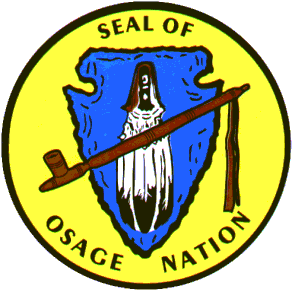
Osage - The Osage Nation's Website
From the Kansas Historical Society's Website
Early History and Campaigns of Expansion
“Osage” was the name that Europeans called the tribe and is likely a corruption of the Osage kinship group name Wah-haz-he, which means “Water People.” It is believed that the Osage originally lived along the Ohio River valley, just west of the Appalachians in present-day Ohio, Kentucky, and West Virginia with other Dhegia Siouan speaking people, such as the Kansa, Ponca, Quapaw, and Omaha. The French were the first Europeans to make contact with the Osage and noted that they were living on the Upper Osage River in present-day western Missouri in 1673. The tribe engaged in campaigns of expansion lasting nearly 100 years, starting around 1700 and the Neosho-Grand valley in present-day Kansas was part of the Osage territory by that time. Around the same time period, the Osage pushed the Caddo groups from the region between the Red and Arkansas-Canadian Rivers in present-day Oklahoma and western Arkansas. The Osage had firm control over the Great Salt Plains in present-day Oklahoma by 1760. The maximum expansion of Osage territory spanned as far south as the Canadian River and down along the Red River as far as Natchitoches, Louisiana, west to the 100th meridian in Dodge City, Kansas, with the Arkansas-Smoky Hill River divide in Kansas as the northern boundary.
Social Structure and Government
The Osage were a patrilineal society with an Omaha-type kinship system. Kinship was central to the formation of the early Osage political structure. The earliest governing structure was the gentile system, which functioned similar to a central or national government to hold the various Osage bands in union. The system began through two primary divisions or moieties, each of which was subsequently divided into phratries. One moiety had two phratries, and the other only one. Each of the phratries had roughly seven clans. The complete gentile system was comprised of 24 clans and multiple sub-clans. Blood-ties through the mutual kinships of the clans unified the Osage. Marriages within one clan or sub-clan were forbidden, which linked all the clans and sub-clans efficiently through marriage. The two moieties had hereditary chiefs with limited executive and judicial power that was primarily to maintain peace within the tribe.
The majority of sociopolitical control of the gentile system belonged to the Ne ke a Shin ka (Society of Little Old Men). This group, functioning as a council, was responsible for the tribe’s history and religious ceremonies. The council was also responsible for maintaining relations with other nations. The council operated as a unicameral legislative body with significant execute and judicial power. Any man in the council was admitted through his ability and achievements. When one of these men died, his widow could take his place in council. These men married only capable and intelligent women for this reason. Individual band chiefs held the second highest level of authority in Osage society but existed outside of the gentile system. These chiefs had local authority for their bands.
Without a doubt, the Osage were one of the largest nations in North America to function as a single political entity. The sociopolitical structure of the Osage was complicated but effective. With authority invested in both each band and the centralized council, the Osage population could grow and expand without dividing. Individual bands could adjust to the needs of their specific environment without the risk of losing any Osage identity. Continuous marriages between clans only strengthen the bonds between various Osage groups. The strength of the Osage government system in conjunction with the tribe’s skill at warfare and trade made it a powerful empire.
From the Kansas Historical Society's Website
Early History and Campaigns of Expansion
“Osage” was the name that Europeans called the tribe and is likely a corruption of the Osage kinship group name Wah-haz-he, which means “Water People.” It is believed that the Osage originally lived along the Ohio River valley, just west of the Appalachians in present-day Ohio, Kentucky, and West Virginia with other Dhegia Siouan speaking people, such as the Kansa, Ponca, Quapaw, and Omaha. The French were the first Europeans to make contact with the Osage and noted that they were living on the Upper Osage River in present-day western Missouri in 1673. The tribe engaged in campaigns of expansion lasting nearly 100 years, starting around 1700 and the Neosho-Grand valley in present-day Kansas was part of the Osage territory by that time. Around the same time period, the Osage pushed the Caddo groups from the region between the Red and Arkansas-Canadian Rivers in present-day Oklahoma and western Arkansas. The Osage had firm control over the Great Salt Plains in present-day Oklahoma by 1760. The maximum expansion of Osage territory spanned as far south as the Canadian River and down along the Red River as far as Natchitoches, Louisiana, west to the 100th meridian in Dodge City, Kansas, with the Arkansas-Smoky Hill River divide in Kansas as the northern boundary.
Social Structure and Government
The Osage were a patrilineal society with an Omaha-type kinship system. Kinship was central to the formation of the early Osage political structure. The earliest governing structure was the gentile system, which functioned similar to a central or national government to hold the various Osage bands in union. The system began through two primary divisions or moieties, each of which was subsequently divided into phratries. One moiety had two phratries, and the other only one. Each of the phratries had roughly seven clans. The complete gentile system was comprised of 24 clans and multiple sub-clans. Blood-ties through the mutual kinships of the clans unified the Osage. Marriages within one clan or sub-clan were forbidden, which linked all the clans and sub-clans efficiently through marriage. The two moieties had hereditary chiefs with limited executive and judicial power that was primarily to maintain peace within the tribe.
The majority of sociopolitical control of the gentile system belonged to the Ne ke a Shin ka (Society of Little Old Men). This group, functioning as a council, was responsible for the tribe’s history and religious ceremonies. The council was also responsible for maintaining relations with other nations. The council operated as a unicameral legislative body with significant execute and judicial power. Any man in the council was admitted through his ability and achievements. When one of these men died, his widow could take his place in council. These men married only capable and intelligent women for this reason. Individual band chiefs held the second highest level of authority in Osage society but existed outside of the gentile system. These chiefs had local authority for their bands.
Without a doubt, the Osage were one of the largest nations in North America to function as a single political entity. The sociopolitical structure of the Osage was complicated but effective. With authority invested in both each band and the centralized council, the Osage population could grow and expand without dividing. Individual bands could adjust to the needs of their specific environment without the risk of losing any Osage identity. Continuous marriages between clans only strengthen the bonds between various Osage groups. The strength of the Osage government system in conjunction with the tribe’s skill at warfare and trade made it a powerful empire.

